Compensation for pitch-shifted auditory feedback during the production of Mandarin tone sequences
- PMID: 15376682
- PMCID: PMC1224717
- DOI: 10.1121/1.1763952
Compensation for pitch-shifted auditory feedback during the production of Mandarin tone sequences
Abstract
Recent research has found that while speaking, subjects react to perturbations in pitch of voice auditory feedback by changing their voice fundamental frequency (F0) to compensate for the perceived pitch-shift. The long response latencies (150-200 ms) suggest they may be too slow to assist in on-line control of the local pitch contour patterns associated with lexical tones on a syllable-to-syllable basis. In the present study, we introduced pitch-shifted auditory feedback to native speakers of Mandarin Chinese while they produced disyllabic sequences /ma ma/ with different tonal combinations at a natural speaking rate. Voice F0 response latencies (100-150 ms) to the pitch perturbations were shorter than syllable durations reported elsewhere. Response magnitudes increased from 50 cents during static tone to 85 cents during dynamic tone productions. Response latencies and peak times decreased in phrases involving a dynamic change in F0. The larger response magnitudes and shorter latency and peak times in tasks requiring accurate, dynamic control of F0, indicate this automatic system for regulation of voice F0 may be task-dependent. These findings suggest that auditory feedback may be used to help regulate voice F0 during production of bi-tonal Mandarin phrases.
Figures





References
-
- Abbs JH, Gracco VL. “Control of complex motor gestures: Orofacial muscle responses to load perturbations of lip during speech,”. J Neurophysiol. 1984;51:705–723. - PubMed
-
- Alipour-Haghighi F, Titze IR, Durham P. “Twitch response in the canine vocalis muscle,”. J Speech Hear Res. 1987;30:290–294. - PubMed
-
- Brooke JD, Collins DF, Boucher S, McIlroy WE. “Modulation of human short latency reflexes between standing and walking,”. Brain Res. 1991;548:172–178. - PubMed
-
- Burnett TA, Freedland MB, Larson CR, Hain TC. “Voice f0 responses to manipulations in pitch feedback,”. J Acoust Soc Am. 1998;103:3153–3161. - PubMed
-
- Burnett TA, Larson CR. “Early pitch shift response is active in both steady and dynamic voice pitch control,”. J Acoust Soc Am. 2002;112:1058–1063. - PubMed
Publication types
MeSH terms
Grants and funding
LinkOut - more resources
Full Text Sources

